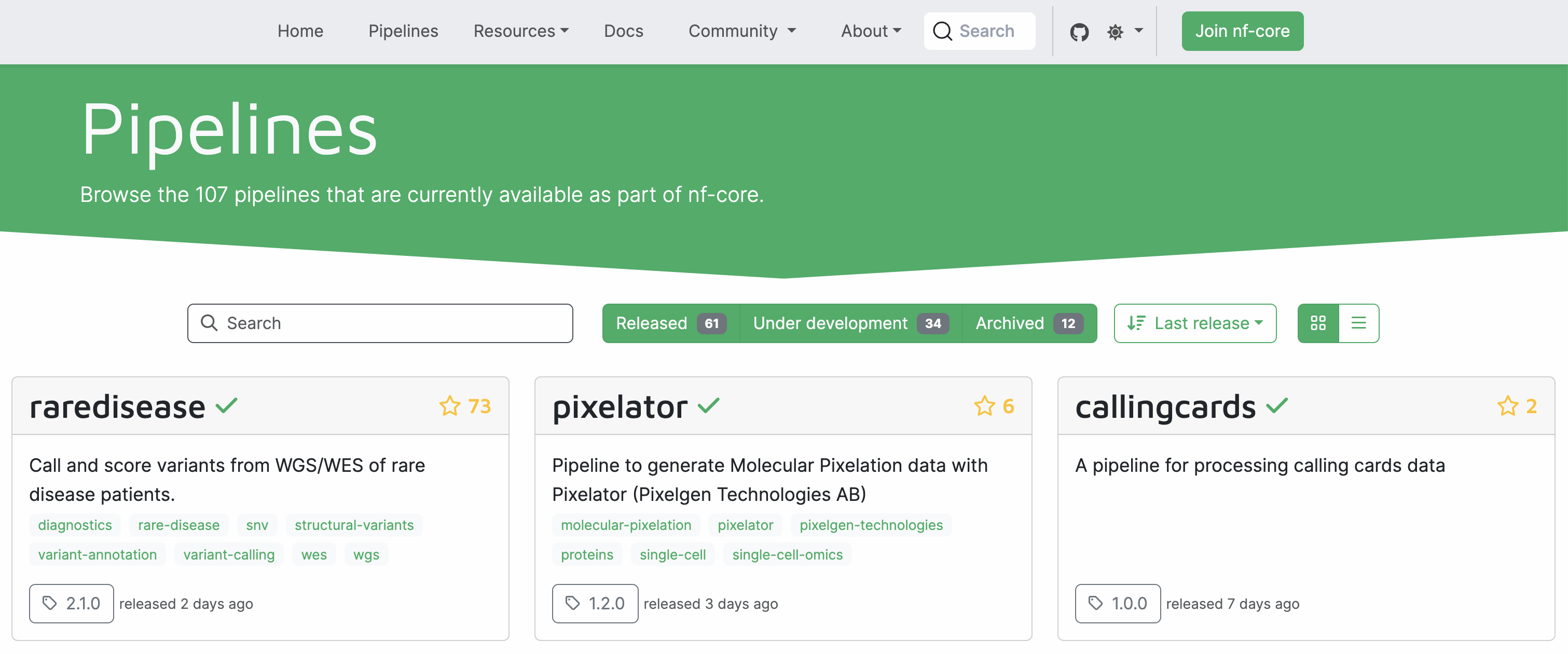2. What is nf-core?¶

nf-core is a community effort to collect a curated set of analysis pipelines built using Nextflow.
nf-core provides a standardised set of best practices, guidelines, and templates for building and sharing bioinformatics pipelines. These pipelines are designed to be modular, scalable, and portable, allowing researchers to easily adapt and execute them using their own data and compute resources.
One of the key benefits of nf-core is that it promotes open development, testing, and peer review, ensuring that the pipelines are robust, well-documented, and validated against real-world datasets. This helps to increase the reliability and reproducibility of bioinformatics analyses and ultimately enables researchers to accelerate their scientific discoveries.
Key Features of nf-core pipelines
- Documentation
- nf-core pipelines have extensive documentation covering installation, usage, and description of output files to ensure that you won't be left in the dark.
- CI Testing
- Every time a change is made to the pipeline code, nf-core pipelines use continuous-integration testing to ensure that nothing has broken.
- Stable Releases
- nf-core pipelines use GitHub releases to tag stable versions of the code and software, making pipeline runs totally reproducible.
- Packaged software
- Pipeline dependencies are automatically downloaded and handled using Docker, Singularity, Conda, or other software management tools. There is no need for any software installations.
- Portable and reproducible
- nf-core pipelines follow best practices to ensure maximum portability and reproducibility. The large community makes the pipelines exceptionally well-tested and easy to execute.
- Cloud-ready
- nf-core pipelines are tested on AWS after every major release. You can even browse results live on the website and use outputs for your own benchmarking.
nf-core is published in Nature Biotechnology: Nat Biotechnol 38, 276–278 (2020). Nature Biotechnology. An updated preprint is available at bioRxiv.
2.1 nf-core pipelines¶
There are currently 113 nf-core pipelines. These pipelines are at various stages of development, with 68 released, 32 under development, and 13 archived (October 2024).
The nf-core website hosts a full list of pipelines, as well as their documentation, which can be explored.

Each released pipeline has a dedicated page that includes 6 documentation sections:
- Introduction: An introduction and overview of the pipeline
- Usage: Descriptions of how to execute the pipeline
- Parameters: Grouped pipeline parameters with descriptions
- Output: Descriptions and examples of the expected output files
- Results: Example output files generated from the full test dataset
- Releases & Statistics: Pipeline version history and statistics
Each section should be explored by a user to understand what the pipeline does and how it can be configured.
Exercise
Explore the nf-core website to see the range of resources available.
2.2 Pulling an nf-core pipeline¶
Unless you intend to develop an nf-core pipeline independently, you do not need to clone a copy of a pipeline.
Instead, use Nextflow’s pull command:
The nextflow run command
The nextflow run command will also automatically pull the pipeline.
Nextflow will pull the pipelines default GitHub branch if a pipeline version is not specified. The master branch is the default branch for nf-core pipelines with a stable release and the dev branch for pipelines that are still being developed.
Pipelines pulled from GitHub using Nextflow are automatically stored in a Nextflow assets folder (default: $HOME/.nextflow/assets/).
nf-core pipelines use GitHub releases to tag stable versions of the code and software. You can execute different versions of a pipeline using the -revision or -r option.
Similarly, you can use the -r option to specify a specific GitHub branch. For example, the dev branch of the nf-core/demo pipeline could be pulled with the command:
If updates to a remote pipeline have been made, run the pull command to update or revert your local copy.
Exercise
Pull the nf-core/demo pipeline:
Use the list command to view your cached pipelines:
View your pulled pipelines in the nextflow assets folder:
Congratulations! You have now ready to start running the nf-core/demo pipeline!